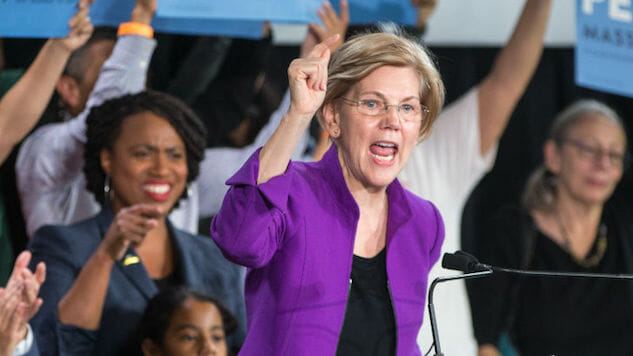The Working Families Party Has a Perfect Opportunity to Clear the Air
Photo courtesy of Getty
A little background before we get to the main point: The Working Families Party, a traditionally leftist organization, announced Monday that they were endorsing Elizabeth Warren for president. This was a little bit of a surprise, because the group endorsed Bernie Sanders in 2016, and based on their politics a lot of people had them pegged for a “Bernie first, Warren second, everyone else third” stance. It was also a bit surprising to see them endorse so early. The Times and others covered it as a big loss for Sanders, and a gain for Warren—whose team had put a good amount of energy into securing the endorsement—and life seemed to move on.
Then people began to learn about the mechanism behind the endorsement. Here was the problem:
But the announcement was met with derision from some of Mr. Sanders’s supporters. The national committee leaders — 56 people — held 50 percent of the voting power, with party members accounting for the other 50 percent. Several Sanders supporters called for the Working Families Party to release the full vote totals, which it has declined to do.
That methodology leaves open the possibility that the total votes of everyone involved in the party went to Sanders, even by a large majority, but were canceled out by the heavier influence of party leadership. Basically, they were doing superdelegates. Which means that the final vote total, 61% to Warren and 36% to Sanders, is almost comically meaningless and, at the very least, shouldn’t be expressed in percentages that imply a “one person, one vote” election. Here’s one scenario, that I’m making up off the top of my head, that would produce a 61% to 36% race under their system:
—Party leadership, numbering 25 people, votes 23-2 for Elizabeth Warren.
—Party rank-and-file, numbering 10,000 people, votes 6,400 to 3,000 for Bernie Sanders over Warren, with 600 people voting otherwise.
Under the WFP system, that would give Warren a 61% to 36% victory over Sanders, even though the total vote count would be 6,402 for Sanders, 3,023 for Warren, 600 other. Sanders would have doubled Warren’s total, and captured about 64% of the overall vote.
Again, those numbers are absolutely not real! I have no idea what the vote totals were, because the WFP won’t tell anyone. They told last time, in 2016, when Sanders won 87% of the vote, but this time, mum’s the word. My example, using nice round numbers for simplicity’s sake, only serves to illustrate how it could have gone.
When the WFP was called out on this possibility, they did two things. First, they wrote a post on Medium in which, amid praise for Warren and Sanders and a justification of their system, they refused again to release the numbers. Here’s some of the relevant text:
When we first announced our 2020 process back in June, we were transparent about how we were going to arrive at our decision. We posted details of the process on our website. We restated it at the start of every one of our candidate live-streamed Q&As. All the candidates who participated in our process were aware of the rules and agreed to abide by them. No candidate suggested that we’d need to show internal breakdowns of component parts of our process to satisfy them.
Sure, no candidate did, but now the people are asking for that, so…
We announced the results of our process as a single number that incorporates all the elements of our party. And that’s raised some questions.
As it should, since it’s not an accurate depiction of what actually happened.
But we want to tell you why we’re committed to expressing the result as a single number.
Because we are building a single party. One that values all of our component parts for the unique role they play and refuses to drive false wedges between them.
This reads a lot like PR-speak to me, and feels like a post-hoc justification for not releasing the numbers because, well, it would be embarrassing.
The next big move by the WFP was to release a statement condemning racist and bigoted reactions from Sanders supporters online (“white terror from the left”), which one Twitter user called “nutpicking”—the act of selecting a few examples of ugly social media behavior in order to paint an entire movement with a broad brush, force the campaign to respond with denunciations, and make media outlets cover the hostility on your terms. It worked.
Working Families Party engages in some good old fashioned nutpicking — wherein you take a handful of partisans and portray them as representative of your political opponents. Didn’t take them long to adapt the same strategies as team Clinton did in 2016https://t.co/VsdukKQAMK
— Zaid Jilani (@ZaidJilani) September 19, 2019
sigh pic.twitter.com/H1NZAgYvIX
— DSA Swarthykin Caucus (@QueenInYeIIow) September 20, 2019
And again, they didn’t release the numbers.
Here’s the thing: The WFP has a perfectly fine argument, outlined in their Medium post, as to why their system is good. According to them, they even increased the influence of rank-and-file voters this year! This post is not designed to call them out on corruption, or even to argue that parties like theirs should endorse candidates based on pure popular vote. They might be right, and either way, it’s their call how they vote.
Instead, this is an argument for transparency. I will happily post a mea culpa if I’m wrong, but it seems blatantly obvious to me that Bernie Sanders won their popular vote, and Warren got the endorsement by virtue of the leadership having more power in the endorsement process. And if that’s your system, that’s your system. But the weird rationalizations and the secrecy are a terrible look for a supposedly progressive, populist party, and rather than trying to control the narrative by hiding information, they should stand by their argument about why their system is best, release the numbers, and let the people decide if they agree or not. It’s either, “yes, Sanders won our vote, but our process works,” or, “no, idiots, Elizabeth Warren won by both metrics, so let’s move on.” But I don’t think it’s wrong for people to be upset that a party espousing progressive ideals is operating like a cabal of tobacco executives.
There’s a great chance to clear the air here, but WFP leadership will first have to stop conducting their most important processes in the shadows. It’s time to do the right thing.







































